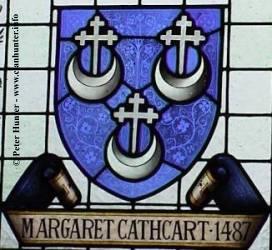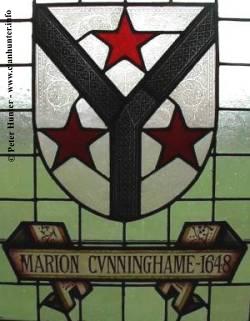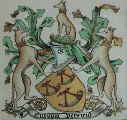|
 The first Hunters arrived in Ayrshire in the last years of the 11th Century. Experts in hunting and fieldcraft with generations of experience in the forests of their land of origin, Normandy, northern France. William Hunter was invited to Scotland by David I, who was himself brought up in the Norman Court. He must have had considerable skills to have been so honoured, he was responsible for providing the Scottish Court with meat and game, a position that the Hunters held throughtout the Middle Ages and beyond. In papers relating to the King's Inquisition in 1116, we find mention of Williemo Venator (William the Hunter, 1st Laird) who was appointed as Royal Huntsman while his wife had the honour of serving Queen Matilda as lady-in-waiting. William put his expertise to good use in the wild forests and fens, then rich with wildlife, which surrounded the site of the timber fortress later to become Hunter's Toun. As recognition of his family's skills the title of Royal Huntsman became a hereditary appointment. The first Hunters arrived in Ayrshire in the last years of the 11th Century. Experts in hunting and fieldcraft with generations of experience in the forests of their land of origin, Normandy, northern France. William Hunter was invited to Scotland by David I, who was himself brought up in the Norman Court. He must have had considerable skills to have been so honoured, he was responsible for providing the Scottish Court with meat and game, a position that the Hunters held throughtout the Middle Ages and beyond. In papers relating to the King's Inquisition in 1116, we find mention of Williemo Venator (William the Hunter, 1st Laird) who was appointed as Royal Huntsman while his wife had the honour of serving Queen Matilda as lady-in-waiting. William put his expertise to good use in the wild forests and fens, then rich with wildlife, which surrounded the site of the timber fortress later to become Hunter's Toun. As recognition of his family's skills the title of Royal Huntsman became a hereditary appointment.
In the mid-thirteenth century King Alexander III of Scotland urged his liegeman to build in stone against possible incursion by
 Norsemen. It was probably about this time that the Pele Tower of Hunterston was constructed. From this stronghold the family, allied with other powerful neighbours, faced down the aggression of King Haakon of Norway and drove him to defeat at the battle of Largs in 1263. It sheltered them throughout the Wars of Independence from which the Hunters emerged with their lands intact despite having signed the Ragman Rolls, swearing allegiance to Edward I, in 1296. Having most likely supported William Wallace and certainly Robert the Bruce. In 1374 the great King's grandson Robert II granted William Huntar (10th Laird) a charter for the lands of Ardneil "for faithful services rendered". The Family still possess this ancient document. For many years, the Hunters continued to serve the Scottish Crown as Royal Huntsmen and as soldiers, sometimes at great cost. John Huntar (14th Laird) died with King James at Flodden in 1513 and Mungo Huntar (16th Laird) died for Mary at Pinkie in 1547. Norsemen. It was probably about this time that the Pele Tower of Hunterston was constructed. From this stronghold the family, allied with other powerful neighbours, faced down the aggression of King Haakon of Norway and drove him to defeat at the battle of Largs in 1263. It sheltered them throughout the Wars of Independence from which the Hunters emerged with their lands intact despite having signed the Ragman Rolls, swearing allegiance to Edward I, in 1296. Having most likely supported William Wallace and certainly Robert the Bruce. In 1374 the great King's grandson Robert II granted William Huntar (10th Laird) a charter for the lands of Ardneil "for faithful services rendered". The Family still possess this ancient document. For many years, the Hunters continued to serve the Scottish Crown as Royal Huntsmen and as soldiers, sometimes at great cost. John Huntar (14th Laird) died with King James at Flodden in 1513 and Mungo Huntar (16th Laird) died for Mary at Pinkie in 1547.
As times became more settled the Hunters devoted more time to farming their extensive lands, although they still produced soldiers of distinction over the generations. Gould Hunter-Weston, husband of Jane Hunter-Weston (26th Laird) fought in India at Lucknow in 1857 and their eldest son, Aylmer (27th Laird) was a well known general in the First World War. He later became Member of Parliament for North Ayrshire. During her tenure as Clan Chief, Eleanora (28th Laird) fought in the courts, but lost, a compulsory purchase order for land at Hunterston to build a nuclear power station.
The last Clan Chief, Neil Hunter of Hunterston and of that Ilk, along with his wife Sonia, Madam Hunter of Hunterston, continued the fight against industrialization. He was well known for his sailing prowess and represented the United Kingdom in two Olympic Games during which he won a silver medal. Like many Hunters before him he was in true tradition an expert in archery.
The present Clan Chief, Madam Pauline Hunter of Hunterston and of that Ilk and 30th Laird, is continuing to build a secure future for Hunterston and develop the Clan Hunter Associations worldwide
|





 Norsemen. It was probably about this time that the Pele Tower of Hunterston was constructed. From this stronghold the family, allied with other powerful neighbours, faced down the aggression of King Haakon of Norway and drove him to defeat at the battle of Largs in 1263. It sheltered them throughout the Wars of Independence from which the Hunters emerged with their lands intact despite having signed the Ragman Rolls, swearing allegiance to Edward I, in 1296. Having most likely supported William Wallace and certainly Robert the Bruce. In 1374 the great King's grandson Robert II granted William Huntar (10th Laird) a charter for the lands of Ardneil "for faithful services rendered". The Family still possess this ancient document. For many years, the Hunters continued to serve the Scottish Crown as Royal Huntsmen and as soldiers, sometimes at great cost. John Huntar (14th Laird) died with King James at Flodden in 1513 and Mungo Huntar (16th Laird) died for Mary at Pinkie in 1547.
Norsemen. It was probably about this time that the Pele Tower of Hunterston was constructed. From this stronghold the family, allied with other powerful neighbours, faced down the aggression of King Haakon of Norway and drove him to defeat at the battle of Largs in 1263. It sheltered them throughout the Wars of Independence from which the Hunters emerged with their lands intact despite having signed the Ragman Rolls, swearing allegiance to Edward I, in 1296. Having most likely supported William Wallace and certainly Robert the Bruce. In 1374 the great King's grandson Robert II granted William Huntar (10th Laird) a charter for the lands of Ardneil "for faithful services rendered". The Family still possess this ancient document. For many years, the Hunters continued to serve the Scottish Crown as Royal Huntsmen and as soldiers, sometimes at great cost. John Huntar (14th Laird) died with King James at Flodden in 1513 and Mungo Huntar (16th Laird) died for Mary at Pinkie in 1547.